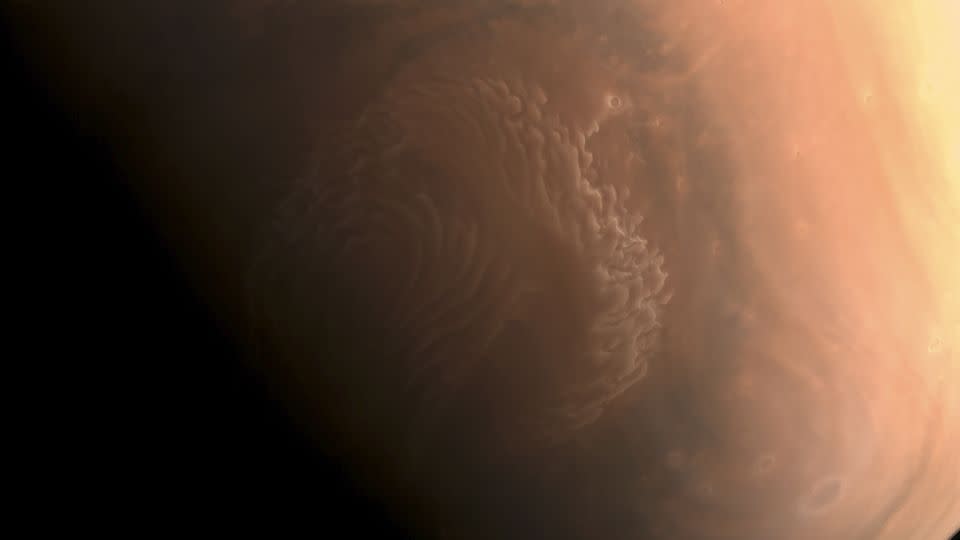China’s historic attempt to bring samples from Mars to Earth could launch as soon as 2028, two years earlier than previously stated, according to a senior mission official.
The country’s Tianwen-3 mission would carry out two launches “around 2028” to retrieve the Martian samples, chief mission designer Liu Jizhong said at a deep-space exploration event in eastern China’s Anhui province last week.
The projected mission launch is more ambitious than a 2030 target announced by space officials earlier this year, though the timeline has fluctuated in recent years. A 2028 target appears to return to a launch plan described in 2022 by a senior scientist involved with the Tianwen program – a mission profile that would see samples returned to Earth by 2031.
The latest remarks follow China’s landmark success retrieving the first samples from the far side of the moon in June.
It also comes as an effort by NASA and the European Space Agency to retrieve Mars samples remains under assessment amid concerns over budget, complexity and risk. The US space agency, which first landed on Mars decades ago, said it is evaluating faster and more affordable plans to allow for a speedier result than one that would have returned samples in 2040.
Becoming the first country to return samples from Mars would be a significant accomplishment for China’s ambitious space program and leader Xi Jinping’s stated “eternal dream” to make the country a space power.
China’s advances – including uncrewed lunar missions and the establishment of its own orbital space station – come as the US and other countries have ramped up their own space programs amid a growing focus on the potential access to resources and scientific benefits of lunar and deep space exploration.
A key priority of China’s Tianwen-3 mission would be to search for traces of life on Mars. The mission would also attempt technical breakthroughs in surface sampling, takeoff and ascent from the Martian surface, as well as a spacecraft rendezvous in Mars’ orbit, Liu said last week, according to Chinese state media.
In a separate interview with CGTN, the international division of China’s state broadcaster, Liu stressed the challenges associated with the mission, which is slated to involve two initial rocket launches and an unprecedented rocket launch off another planet to return the samples.
“The return mission requires launch from the surface of Mars. It’s actually a small rocket launch – therefore it will be very difficult to ensure the entire flight is reliable,” he said.
China would engage in international cooperation around the mission, including carrying other countries’ payloads and sample and data sharing, as well as planning for future Mars research, Liu was also quoted as saying.


Missions to Mars
Mars has long been seen by scientists as a critical research destination that could reveal information about the existence of life outside Earth – and our own origins in the solar system.
China’s Tianwen planetary exploration mission series, whose name roughly translates to “questions to heaven,” had its first success in 2021, when its Tianwen-1 probe reached Mars’ orbit and deployed the Zhurong rover to the planet’s surface.
Zhurong’s May 15, 2021, landing in a large plain known as Utopia Planitia made China the third country after the Soviet Union and the United States to touch down on the planet, which at its closest is more than 30 million miles from Earth.
The rover’s primary mission was to search for signs of ancient life and investigate minerals, environment and distribution of water and ice in the plain.
Data returned from the rover’s initial survey of the basin suggested that the Utopia Planitia basin had contained water during a period of time tens of millions of years ago when many scientists believed Mars to be dry and cold, according to 2022 research.
The rover was designed to have a working duration of 90 days on Mars, but continued for 358 days and traveled 1,921 meters (6,302 feet) on the planet. It went into hibernation in May 2022 due to what Chinese scientists said was an “unpredictable accumulation” of dust.
The US had its first landing on the planet in 1976 with its Viking 1 mission, which included a lander that operated for more than six years. It was a feat that surpassed the Soviet Union’s Mars 3 spacecraft, which landed on the Martian surface in 1971, but only transmitted signal for some 20 seconds.
The most recent US landing on Mars was that of NASA’s Perseverance rover, which touched down in the Jezero crater in 2021 and has since been collecting samples for a later return to Earth.
NASA chief Bill Nelson earlier this year called the US’ planned Mars sample return mission “one of the most complex missions NASA has ever undertaken.”
The US space agency announced in April that it was seeking new, innovative ways to retrieve surface samples, after a budget plan ballooned to as much as $11 billion with a timeframe of sample returns by 2040. In June, it announced it was backing a handful of 90-day studies to find “more affordable and faster” methods.
For more CNN news and newsletters create an account at CNN.com
